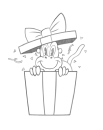Check out the premium course for additional lessons, demos, assignments and critiques!
The Joy and Grief of Distortion
You see distortion when things shift between looking normal and looking extreme. You might draw something as it appears naturally, or you might push it to look more dramatic. Sometimes this feels exciting (the joy), and other times it feels confusing (the grief).
Spatial distortion is almost impossible to draw accurately without plan projections. Those help you map how objects shift in space, but it takes work before you see if your distortion looks right. With or without plan projections, you’ll notice that wide angle distortions happen when vanishing points come closer together.
Placing the Viewer
A key factor is proximal placement, which is how close or far the viewer is to the scene (the Z axis). That distance affects where your vanishing points go.
• When the viewer is far away, vanishing points spread out.
• When the viewer is close, vanishing points come together.
Farther vanishing points result in a flatter look, everything appears more uniform in size. Closer vanishing points result in a more stretched look, things near you look much bigger, and distant things look much smaller.
Vanishing Points and Depth
Remember that isometric perspective ignores vanishing points. Angles remain consistent and nothing changes size no matter how far it recedes.
As soon as you introduce a vanishing point, lines converge, pulling your eye into a sense of depth. The difference between close and far becomes more pronounced. When sketching freehand in two-point perspective:
- Start with your eye level.
- Choose your vanishing points:
- Far apart = distant view, flattened depth.
- Close together = closer view, exaggerated depth.
Try both setups to see how they affect the sense of space.
One-Point vs. Two-Point Distortion
One-point perspective doesn’t let you spread points apart, yet you can still create extreme depth by bringing the viewer in closely. For example, two pencils viewed from a distance look nearly the same size, but if you move close and open the angle, the near pencil looks huge while the far pencil looks tiny.
It’s the same for heights, two chess pieces far away look similar in size, but up close, one towers while the other shrinks. This is the secret behind exaggerated depth, the closer an object is, the bigger it appears.
Practical Examples
• Tank Drawing: Viewed from far away, a tank’s size barely changes as it moves toward or away. Place the viewer close, and suddenly the barrel pointing at you becomes massive compared to the rest.
• Jack Davis Artwork: In one illustration, everyone looks similar in size because the viewer is far. In another, the pitcher and batter loom so large, they don’t even fit in the frame, while the outfielder in the distance is half their size.
If you want to push depth even further, remember: close things get bigger, distant things get smaller. You can stretch that difference to extreme levels.
Practice and Exploration
Keep filling your mind with examples, from photographs or real scenes, and notice how placement of the viewer changes everything. Imagine how big or small objects might appear, then draw that vision. If you aren’t sure where to begin, remember,
Draw what you imagine you will imagine.
Check out the premium course for additional lessons, demos, assignments and critiques!
















